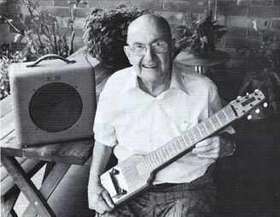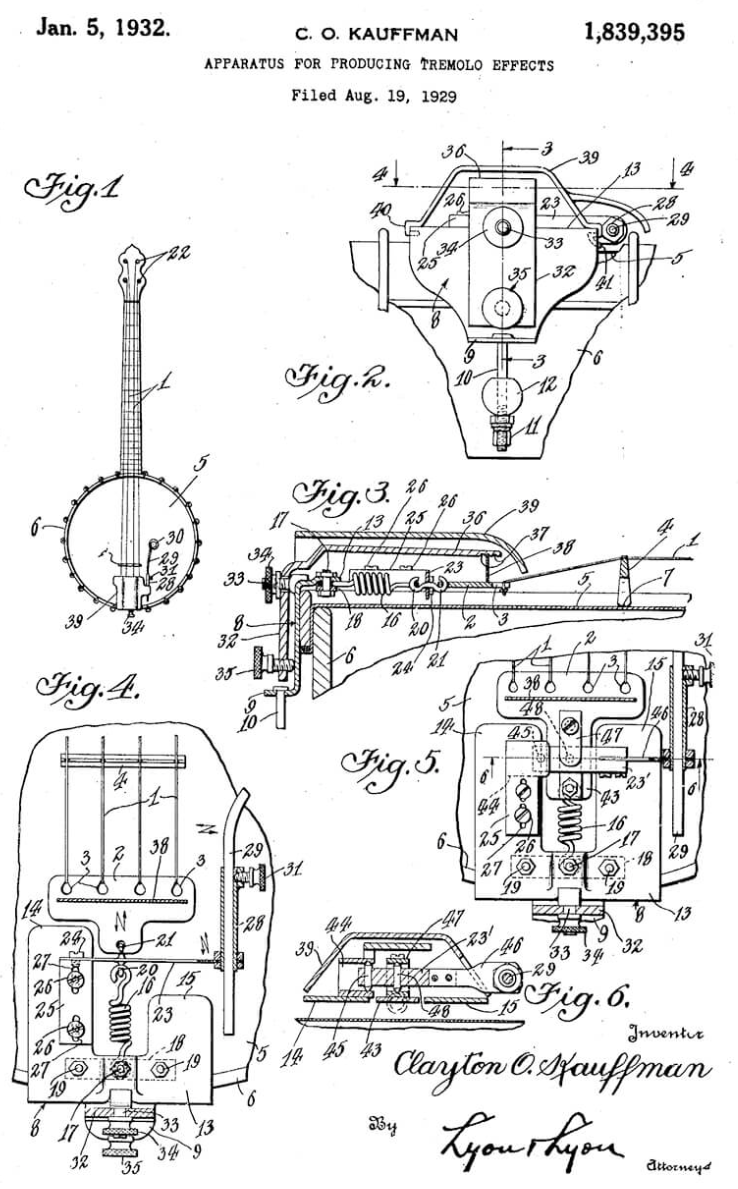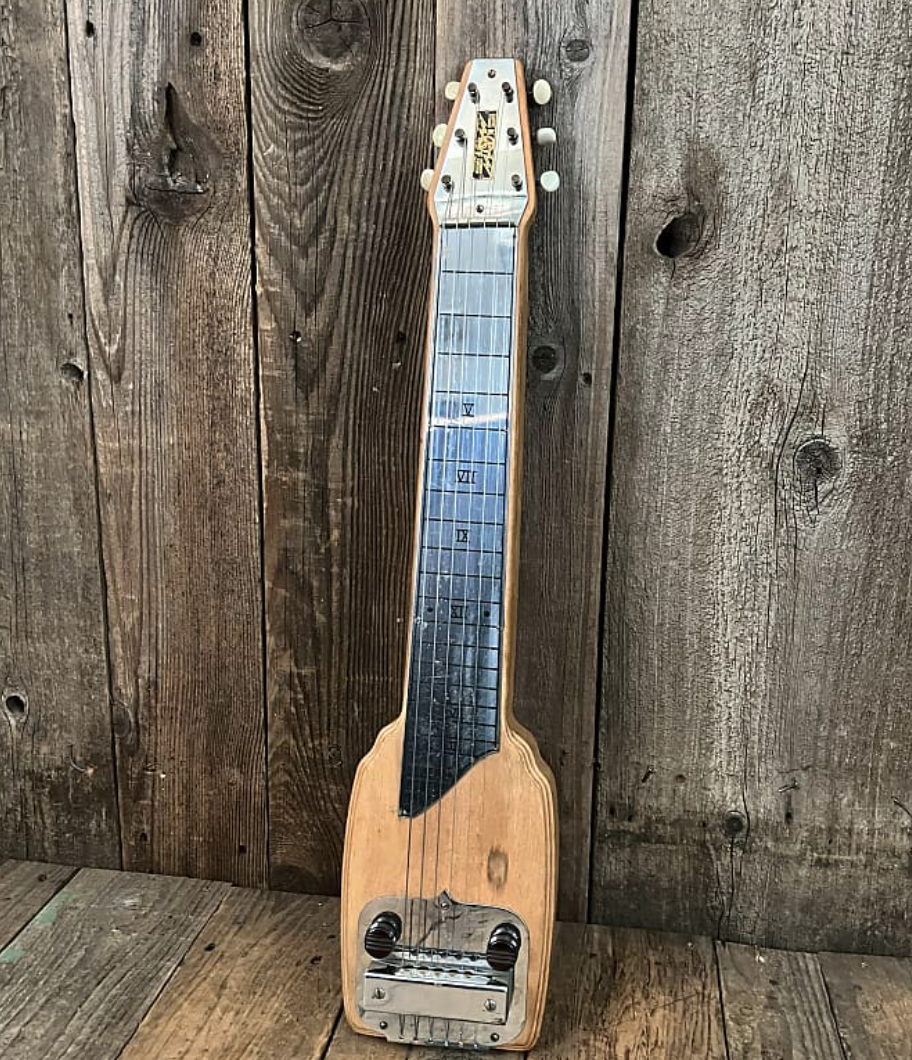Pioneer Behind the Virola Vibrato and Early Electric Guitar Innovation: Clayton Orr “Doc” Kauffman
Clayton Orr “Doc” Kauffman was a pivotal figure in the development of early electric guitar innovation. His work had a lasting impact on the music industry, particularly with the introduction of the Virola Vibrato.
As a pioneer in guitar manufacturing, Doc Kauffman’s contributions went beyond just creating new hardware; he helped shape the sound of modern music. The Virola Vibrato, one of his most notable creations, became an essential component for many musicians.
With a career marked by innovation and a passion for music, Doc Kauffman’s legacy continues to influence guitar design and music production today.

The Early Life of Clayton Orr Kauffman
The story of Clayton Orr “Doc” Kauffman’s early life is one of curiosity, family support, and an innate passion for music. Growing up in a family that encouraged his interests, Kauffman’s foundation in music was laid early on.
Family Background and Education
Kauffman’s family played a significant role in his early exposure to music. His parents, though not professional musicians themselves, fostered an environment where music was appreciated and explored. This nurturing atmosphere allowed Kauffman to develop his musical talents from a young age.
Educationally, Kauffman’s journey was marked by a curiosity for how things worked, a trait that would later serve him well in his career as an innovator and instrument designer. His formal education provided a solid grounding in the principles of music and mechanics.
Musical Beginnings and Interests
Kauffman’s musical beginnings were rooted in traditional instruments, but it wasn’t long before he became fascinated with the potential of music and technology to come together. This intersection of music and innovation became a driving force in his life, leading him to explore various aspects of sound and instrument design.
As he delved deeper into the world of music, Kauffman’s interests expanded to include not just playing instruments, but understanding and improving them. This curiosity about the inner workings of musical instruments and the science behind sound production laid the groundwork for his future contributions to the field of electric guitar innovation.
How “Doc” Earned His Nickname and Early Career
The origin of “Doc” Kauffman’s nickname is a fascinating story that highlights his early reputation as a talented and resourceful individual. This nickname, which became synonymous with innovation in the music industry, was earned through his exceptional skills and contributions to early electric guitar technology.
The Origin Story Behind the Moniker
Kauffman’s nickname “Doc” is believed to have originated from his ability to “doctor” or fix musical instruments, showcasing his ingenuity and problem-solving skills. This moniker stuck as he continued to make significant contributions to the music world, particularly in the development of electric guitars.
As a young man with a passion for music and inventing, Kauffman was always looking for ways to improve instruments and equipment. His natural talent and curiosity led him to experiment with various modifications, earning him recognition among his peers.
Kauffman’s Reputation as a Musical Problem Solver
Kauffman’s reputation as a musical problem solver was built on his ability to diagnose and fix complex issues with musical instruments. His expertise extended beyond mere repairs; he was known for enhancing instruments with innovative features that improved their sound and playability.
Through his work, Kauffman demonstrated a deep understanding of the mechanical and acoustic aspects of musical instruments. This knowledge allowed him to craft solutions that were not only effective but also ahead of their time, contributing to his growing reputation in the music community.
As Kauffman’s skills continued to evolve, so did his influence on the development of early electric guitars. His contributions would eventually play a crucial role in shaping the sound of modern music, with his innovations remaining relevant even as technology advanced.
Kauffman’s Entry into Musical Instrument Design
Kauffman’s entry into the world of musical instrument design was marked by experimentation and a willingness to challenge conventional approaches. His journey into this field was influenced by his early interests in music and sound technology.
First Experiments with Sound Technology
Kauffman’s fascination with sound technology led him to conduct his first experiments. He explored various methods to enhance and manipulate sound, laying the groundwork for his future innovations in musical instrument design. These early experiments were crucial in shaping his understanding of acoustic principles and their application in musical instruments.
Early Employment at Rickenbacker
Kauffman’s career in musical instrument design took a significant turn with his employment at Rickenbacker. Working alongside other pioneers in the field, Kauffman was exposed to cutting-edge ideas and technologies that further fueled his passion for innovation. His role at Rickenbacker provided him with hands-on experience and insights into the manufacturing and design of musical instruments.
Initial Instrument Modifications and Repairs
During his early days at Rickenbacker, Kauffman was involved in the modification and repair of musical instruments. This work not only honed his technical skills but also gave him a deeper understanding of the needs of musicians. By addressing the challenges faced by musicians through instrument modifications, Kauffman began to develop solutions that would later become integral to his designs.
The combination of Kauffman’s experimental approach, his experience at Rickenbacker, and his work on instrument modifications laid the foundation for his contributions to musical instrument design. His innovative spirit and problem-solving skills positioned him as a key figure in the evolution of electric guitars and related technologies.
The Revolutionary Vibrato Bar: Development of the Virola System
The development of the Virola Vibrato system marked a significant milestone in the evolution of electric guitars, thanks to ‘Doc’ Kauffman’s ingenuity. This innovation was driven by the need to overcome certain tonal limitations inherent in early electric guitar designs.
Tonal Limitations Kauffman Aimed to Overcome
Early electric guitars lacked the expressive qualities that musicians sought. The primary issue was the inability to smoothly vary the pitch of sustained notes, a feature that was becoming increasingly desirable as musical styles evolved.
Kauffman identified this limitation and set out to create a device that could provide a more dynamic sound, allowing for vibrato effects that were previously difficult or impossible to achieve with traditional guitar techniques.
Technical Development and Prototyping Process
The journey to develop the Virola Vibrato involved extensive experimentation and prototyping. Kauffman worked tirelessly to refine his design, testing various mechanisms and materials to achieve the desired effect.
The technical challenges were significant, requiring Kauffman to innovate not just the vibrato mechanism itself but also how it would be integrated into the guitar’s body and electronics.
Patent Filing and Initial Production Challenges
Once the Virola Vibrato’s design was finalized, Kauffman proceeded to file for a patent, a step that underscored the novelty and significance of his invention.
The initial production phase presented its own set of challenges, including manufacturing complexities and ensuring consistency across units. Despite these hurdles, the Virola Vibrato quickly gained acceptance among musicians.

The successful introduction of the Virola Vibrato system not only highlighted Kauffman’s innovative capabilities but also paved the way for future advancements in guitar technology.
Partnership with Leo Fender: The K&F Manufacturing Corporation
When “Doc” Kauffman met Leo Fender, it sparked a collaboration that would change the face of guitar manufacturing. Their partnership led to the establishment of the K&F Manufacturing Corporation, a venture that embodied the innovative spirit of both men.
The Fateful Meeting
The story of how Kauffman and Fender met is a testament to the power of networking within the music industry. At the time, both men were deeply involved in their respective careers in musical instrument manufacturing. Their meeting was facilitated by mutual acquaintances who recognized the potential benefits of their collaboration.
Formation of Their Business Relationship
The business relationship between Kauffman and Fender was built on a foundation of mutual respect and a shared passion for innovation. They quickly discovered that their skills complemented each other perfectly, with Kauffman’s expertise in instrument design and Fender’s acumen in business and marketing.
Their partnership was not just about creating new products but also about pushing the boundaries of what was possible in guitar manufacturing. They were driven by a common goal: to produce high-quality, innovative instruments that would revolutionize the music industry.

Products and Prototypes Developed During Their Partnership
During their time together at K&F Manufacturing Corporation, Kauffman and Fender worked on several groundbreaking projects. One of their most notable achievements was the development of the Virola vibrato system, a technology that significantly enhanced the expressive capabilities of electric guitars.
Key Products and Innovations:
- Virola Vibrato System
- Early Electric Guitar Prototypes
- Advanced Amplifier Designs
The collaboration between Kauffman and Fender resulted in some remarkable innovations, as highlighted in the table below, which summarizes their key achievements and the impact on guitar manufacturing.
| Innovation | Description | Impact |
|---|---|---|
| Virola Vibrato System | A revolutionary tremolo system for electric guitars | Enhanced expressive capabilities for guitarists |
| Early Electric Guitar Prototypes | Experimental designs that pushed the boundaries of guitar manufacturing | Influenced the development of future electric guitars |
| Advanced Amplifier Designs | Innovative amplifier designs that improved sound quality | Set new standards for amplifier technology |
The partnership between “Doc” Kauffman and Leo Fender was a defining period in the history of guitar manufacturing, marked by significant innovations that continue to influence the music industry today.
Technical Breakdown of the Virola Vibrato Bar Mechanism
The Virola Vibrato bar mechanism, developed by Clayton Orr “Doc” Kauffman, brought a new level of expressiveness to guitar music. This innovation was crucial in the evolution of electric guitars, offering musicians a tool to add emotional depth to their performances.
Mechanical Design Elements and Materials
The Virola Vibrato bar was designed with a focus on durability and functionality. It incorporated a robust mechanical system that allowed for smooth pitch variations. The materials used were selected for their strength and resistance to wear, ensuring that the vibrato bar would remain reliable over time.
The mechanism involved a complex interplay of parts, including springs and pivot points, which worked together to enable the desired pitch bending effects. This design was meticulously engineered to provide guitarists with a responsive and intuitive tool for expression.
Advantages Over Previous Tremolo Technologies
Compared to earlier tremolo systems, the Virola Vibrato bar offered several significant advantages. It provided a more stable and consistent pitch modulation, which was a marked improvement over the often erratic performance of earlier designs.
- Improved Tuning Stability: The Virola Vibrato bar maintained tuning stability even during extensive use.
- Enhanced Expressiveness: It allowed for a wider range of expressive pitch variations.
- Durable Construction: The use of high-quality materials ensured longevity.
Sound Characteristics and Performance Benefits
The Virola Vibrato bar imparted a unique sound characteristic to the guitars it was fitted to. It enabled musicians to achieve a rich, dynamic sound with the ability to smoothly transition between notes.
| Feature | Description | Benefit |
|---|---|---|
| Pitch Variation | Smooth and continuous pitch bending | Enhanced musical expression |
| Tuning Stability | Maintains tuning despite frequent use | Reliable performance |
| Durability | Constructed with high-quality materials | Long-lasting |
The performance benefits of the Virola Vibrato bar were quickly recognized by musicians, who appreciated the added dimension it brought to their playing. It became an essential component for many guitarists seeking to expand their musical palette.
Kauffman’s Other Musical Innovations Beyond the Vibrato
Beyond the Virola Vibrato, ‘Doc’ Kauffman’s inventive spirit led to numerous other groundbreaking musical innovations. His work significantly impacted various areas of musical instrument design, showcasing his versatility and genius.
Lap Steel Guitar Contributions
Kauffman’s contributions to lap steel guitar design were substantial. He worked on modifying and enhancing the lap steel guitar, an instrument gaining popularity in the early 20th century, particularly in the context of Western swing and jazz music.
Key innovations included improving the instrument’s playability and tonal quality. Kauffman’s modifications often involved adjusting the action and refining the electronics to achieve a richer, more resonant sound.
Amplification Experiments and Designs
Kauffman was also deeply involved in amplification experiments and designs. He recognized the importance of amplification in enhancing the sound of electric instruments. His work in this area led to the development of more sophisticated amplification systems that could handle the nuances of various instruments.
By experimenting with different amplifier configurations and speaker designs, Kauffman aimed to achieve clearer, more robust sound reproduction. His efforts contributed to the evolution of amplification technology, benefiting not just guitarists but musicians across various disciplines.
Lesser-Known Inventions and Modifications
In addition to his well-documented work on the Virola Vibrato and lap steel guitars, Kauffman made several lesser-known inventions and modifications. These included tweaks to other stringed instruments and experimental electronic components designed to enhance musical performance.
Though not as widely recognized, these innovations demonstrate Kauffman’s comprehensive approach to musical instrument design. His willingness to experiment and push boundaries helped pave the way for future generations of luthiers and musicians.
The Historical Context: Guitar Innovation in the 1930s-40s
The 1930s and 1940s were pivotal decades for guitar innovation, marked by fierce competition and technological breakthroughs. This era saw significant advancements in guitar design, driven by the evolving music scene and the need for instruments that could produce a louder, more versatile sound.
The Competitive Landscape of Guitar Manufacturing
The guitar manufacturing industry in the 1930s and 1940s was highly competitive, with several key players vying for market share. Companies like Rickenbacker, Gibson, and Epiphone were at the forefront, each striving to outdo the others through innovation. This competitive landscape fostered an environment of rapid technological advancement, as manufacturers sought to differentiate their products and capture the attention of musicians.
Technological Limitations of the Era
Despite the innovations, the technological capabilities of the time imposed certain limitations. Materials and manufacturing techniques were not as advanced as they are today, restricting the complexity and quality of instruments that could be produced. Guitar makers had to be resourceful and inventive, often relying on traditional craftsmanship to overcome these challenges.
Market Demands Driving the Need for Innovation
The market demands of the 1930s and 1940s played a crucial role in driving guitar innovation. Musicians required instruments that could be heard over the din of big bands and orchestras, leading to a push for louder, more amplified guitars. The rise of new musical styles, such as electric blues and early rock ‘n’ roll, further accelerated the need for innovative guitar designs that could meet the demands of these emerging genres.
The Dissolution of the Fender-Kauffman Partnership
The Fender-Kauffman partnership, a significant collaboration in the history of electric guitar innovation, eventually came to an end due to various disagreements. This partnership, which had led to the formation of the K&F Manufacturing Corporation, was instrumental in developing innovative guitar designs, most notably the Virola Vibrato system.
Business Disagreements and Different Priorities
As time progressed, Fender and Kauffman began to have differing views on the direction of their company. Business disagreements arose, primarily centered around the focus and priorities of the K&F Manufacturing Corporation. Fender was increasingly focused on expanding his product line and exploring new markets, while Kauffman remained deeply invested in refining and perfecting the Virola Vibrato system.
The divergence in their priorities led to tension within the partnership. Fender’s vision for a broader product range, including amplifiers and other musical instruments, contrasted with Kauffman’s concentration on guitar innovations. This divergence ultimately contributed to the strain on their business relationship.
Contrasting Visions for the Future of Guitar Design
The creative differences between Fender and Kauffman also played a significant role in the dissolution of their partnership. While both were pioneers in guitar design, their approaches and visions for the future diverged. Fender’s focus on creating instruments that were both innovative and commercially viable sometimes put him at odds with Kauffman’s more experimental approach to guitar design.
Kauffman’s relentless pursuit of perfection in the Virola Vibrato system, for instance, was not always aligned with Fender’s more pragmatic considerations for mass production and market appeal. This fundamental difference in their design philosophies contributed to the challenges they faced in maintaining a harmonious and productive partnership.
Kauffman’s Career Path After the Partnership
Following the dissolution of the Fender-Kauffman partnership, Kauffman continued to contribute to the world of musical instrument innovation. He pursued various projects, applying his expertise in sound technology and guitar design to new areas. Kauffman’s work after the partnership not only reflected his personal interests but also continued to influence the broader landscape of guitar innovation.
One of the key areas Kauffman focused on was lap steel guitar design, where he made significant contributions. His experiments with amplification and sound modification also continued, pushing the boundaries of what was possible in electric guitar technology.
The legacy of the Fender-Kauffman partnership, despite its dissolution, remained significant in the history of electric guitar development. The table below summarizes the key aspects of their collaboration and its aftermath.
| Aspect | Fender’s Focus | Kauffman’s Focus |
|---|---|---|
| Business Priorities | Expanding product line, market expansion | Refining Virola Vibrato system |
| Design Philosophy | Commercial viability, mass production | Experimental approach, perfectionism |
| Post-Partnership | Continued guitar innovation, new products | Lap steel guitar design, amplification experiments |
Musicians Who Popularized Kauffman’s Vibrato Bar Innovations
As Kauffman’s vibrato bar hit the music scene, a variety of artists quickly adopted this innovative technology, making it an integral part of their sound. The vibrato bar’s ability to add expression and emotion to music made it an instant hit among musicians looking to expand their tonal palette.
Early Adopters in Western Swing and Jazz
Western swing and jazz musicians were among the first to embrace Kauffman’s vibrato bar. Artists in these genres valued the vibrato bar for its ability to add a rich, wavering quality to their notes, enhancing the emotional impact of their performances.
- Western Swing: Musicians like Bob Wills and the Texas Playboys used the vibrato bar to create the distinctive, wavering sounds that became a hallmark of the genre.
- Jazz: Jazz guitarists appreciated the vibrato bar for its expressive qualities, using it to add subtle nuances to their playing.
Rock and Roll Pioneers Using Vibrato Effects
The advent of rock and roll brought new enthusiasm for the vibrato bar, as it offered a way to add drama and intensity to performances.
- Pioneers: Artists like Dick Dale and Jimi Hendrix were among the rock and roll pioneers who extensively used the vibrato bar to create revolutionary sounds.
- Innovative Techniques: These musicians experimented with the vibrato bar, developing new techniques that further expanded its creative potential.
Signature Sounds Made Possible by Kauffman’s Design
Kauffman’s vibrato bar enabled musicians to create signature sounds that were previously unimaginable. The unique tonal variations it provided helped artists stand out and define their musical identities.
The impact of Kauffman’s innovation can still be heard in music today, with many contemporary artists continuing to use and innovate upon his design.
The Evolution of Vibrato Systems After Kauffman’s Design
Kauffman’s pioneering work on the Virola Vibrato paved the way for subsequent innovations in guitar vibrato systems. The impact of his design can be seen in various aspects of modern electric guitars.
How the Virola Influenced Fender’s Stratocaster Tremolo
The Fender Stratocaster, introduced in 1954, incorporated a tremolo system heavily influenced by Kauffman’s Virola Vibrato. The Stratocaster tremolo retained the core functionality of the Virola while making adjustments to suit Fender’s design philosophy.
Key Features of the Stratocaster Tremolo:
- Floating bridge design for improved stability
- Adjustable tremolo arm for varied vibrato effects
- Synchronized tremolo system for consistent tuning
Competing Systems from Gibson, Bigsby, and Others
While Fender’s Stratocaster tremolo was gaining popularity, other manufacturers like Gibson and Bigsby were developing their own vibrato systems. The competitive landscape drove innovation, resulting in a variety of vibrato designs.
| Manufacturer | Vibrato System | Notable Features |
|---|---|---|
| Gibson | Lyre Vibrola | Distinctive lyre-shaped design, used on various Gibson models |
| Bigsby | Bigsby Vibrato | Tension-adjustable, known for its sustain and stability |
| Fender | Stratocaster Tremolo | Floating bridge, synchronized tremolo system |
Modern Adaptations and Refinements of Kauffman’s Concepts
Today, Kauffman’s original design continues to influence modern guitar manufacturing. Many contemporary vibrato systems build upon or refine the principles established by the Virola Vibrato.
Modern Developments:
- Locking tremolo systems for enhanced tuning stability
- Advanced materials for improved sustain and durability
- Electronic vibrato systems with digital controls
The legacy of Kauffman’s Virola Vibrato is evident in the diverse range of vibrato systems available to musicians today, each offering unique tonal possibilities and playing experiences.
The Enduring Legacy of “Doc” Kauffman in Modern Guitar Design
Doc Kauffman’s innovative spirit and pioneering work in guitar design have left an indelible mark on the music industry. His development of the Virola Vibrato system revolutionized the way musicians interact with their instruments, offering unprecedented tonal expressiveness.
The influence of Kauffman’s designs can be seen in many modern guitars, with manufacturers continuing to evolve and refine his concepts. The Fender Stratocaster’s tremolo system, for example, owes a debt to Kauffman’s early work on vibrato technology.
Today, musicians across genres owe a nod to Doc Kauffman’s ingenuity. His contributions to guitar design have enabled the creation of new sounds and styles, shaping the course of popular music. As the music industry continues to evolve, Kauffman’s legacy serves as a reminder of the power of innovation and creativity.
The enduring legacy of Doc Kauffman is a testament to the lasting impact of his work. As modern guitar design continues to advance, it is clear that Kauffman’s pioneering efforts will remain an essential part of the instrument’s evolution.

